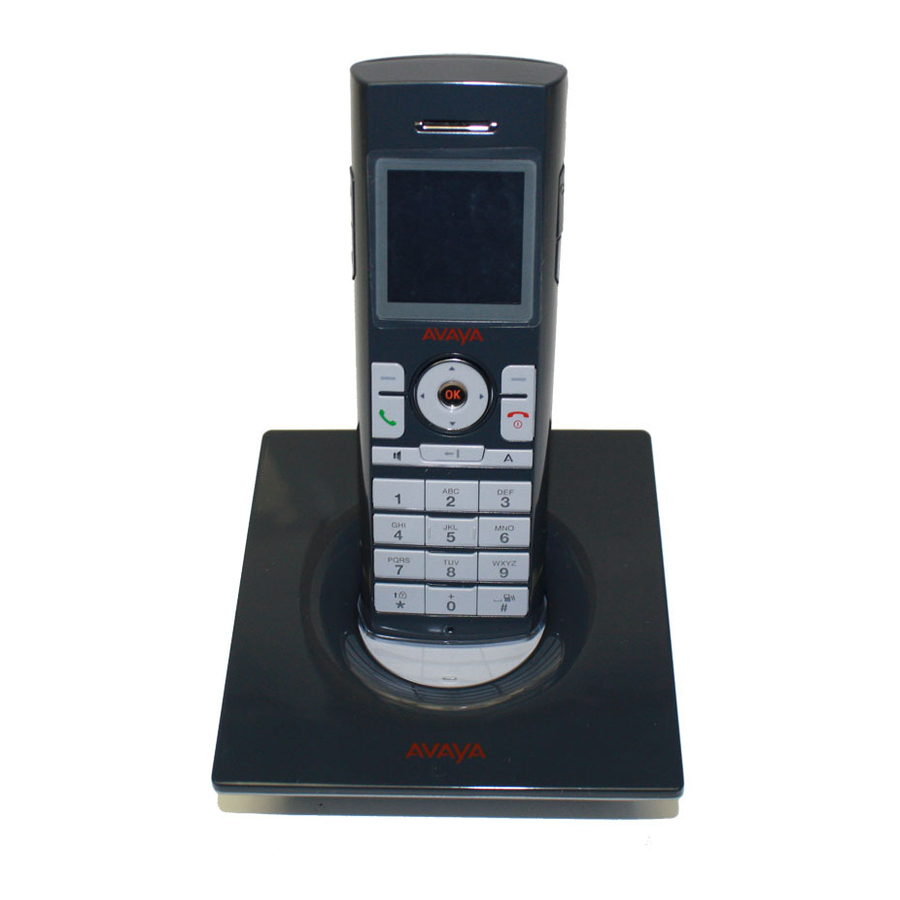Avaya 3645 Посібник з монтажу - Сторінка 13
Переглянути онлайн або завантажити pdf Посібник з монтажу для Телефон Avaya 3645. Avaya 3645 19 сторінок. Co-existence with ip wireless handset offering
Також для Avaya 3645: Короткий довідник (2 сторінок), Посібник з конфігурації (8 сторінок)

Installation Guide
4.1.3 Multiple AVPPs
For installations with multiple AVPPs, call resources are automatically allocated between the APs and
the wireless telephones by those devices' Media Access Control (MAC) addresses. In most instances,
because of the large number of wireless telephones and APs expected in such an application, the
distribution of call processing will be relatively even across all AVPPs.
Installations with multiple AVPPs are configured to have a Registration AVPP and one or more
secondary AVPPs. If any AVPP fails and can no longer be detected, the call processing will
automatically be redistributed among the remaining AVPPs. Some active calls may be lost during this
process, but the full system restoration does not require any manual reconfiguration.
4.2 Access Point Quality of Service (QoS)
Wi-Fi Multimedia (WMM) is a specification and certification program created by the Wi-Fi Alliance,
based upon the Enhanced Distributed Channel Access (EDCA) mechanism defined in the 802.11e
standard. Avaya handsets support two QoS methods; the proprietary SpectraLink Voice Priority (SVP)
developed to meet a gap which existed before 802.11e ratification and the standards-based Wi-Fi
Alliance Wireless Multi-Media (WMM).
Avaya wireless telephone installations, even if the WLAN is being used only for voice. Without a
method of prioritization for voice packets, the lack of a controlled delivery method will result in poor
audio quality, reduced capacity, poor handoffs and/or poor battery life even with only voice devices on
the network. In a mixed configuration using the AVPP and WMM refer to the Configuration and
Deployment Guides for Polycom VIEW Certified and Field Verified WLANs for specific configuration
requirements.
Basic WMM implementation in access points does not include Unscheduled-Automatic Power Save
Delivery (U-APSD) and Call Admission Control (CAC), which are also defined in the 802.11e standard.
Therefore, the AVPP is required to ensure the timing and delivery of Avaya voice packets, which is
critical as the user hands off between APs and for improved battery life. The AVPP also provides call
admission control and allows the number of calls per AP to be configured.
4.3 VIEW Certification
Avaya 3616, 3620, 3626, 3641, and 3645 support Polycom's Voice Interoperability for Enterprise
Wireless (VIEW) Certification Program which certifies Wi-Fi network infrastructure products to be
interoperable with Avaya wireless telephones. The objective of the program is to promote enterprise
Wi-Fi telephony interoperability and performance. VIEW Certification provides customers:
•
Confidence in interoperability and enterprise-grade performance
•
Confidence in integration and partnership between vendors
•
Assurance of excellent voice quality, seamless roaming, maximum capacity and robust network
security
•
Detailed Configuration and Deployment Guides
Information regarding VIEW Certified WLANs can be found on Polycom's website. Configuration
Guides for specific AP models are also available on the Polycom website and should be closely
followed to ensure a proper deployment for voice.
http://www.polycom.com/usa/en/support/voice/wi-fi/wi-fi.html
Octiober 2008
SVP or WMM-enabled APs and an AVPP are required for all
13
